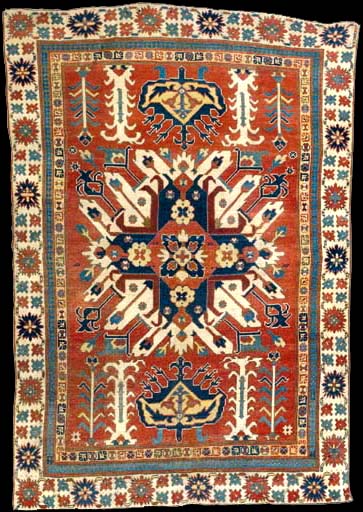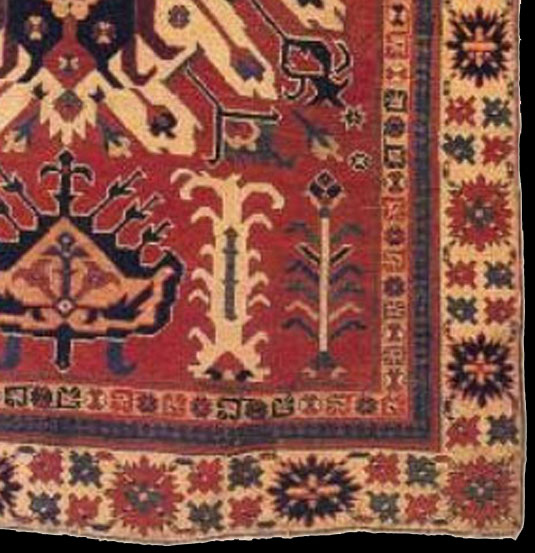|
A CHELABERD RUG
SOUTH CAUCASUS, LATE 18TH CENTURY
Price Realized £29,375 ($42,506)
Christie's Sale Information
Sale 6499
ORIENTAL RUGS & CARPETS
18 October 2001
London, King Street
Lot Description
A CHELABERD RUG
South Caucasus, late 18th century
The shaded brick-red field scattered with angular hooked vine together
with bold palmettes at each end and minor flowerheads around a central
starburst medallion, in an ivory crab-rosette border between cream floral
meander and reciprocal skittle-pattern stripes, outer
stripes missing, scattered repiling 6ft.3in. x 4ft.2in. (191cm. x 127cm.)
Literature
Burns, James B.: The Caucasus,
Traditions in Weaving, Seattle,
1987, no.10.
Hali 36, October/December 1987,
cover illustration and p.62.
Lot Notes
Having been on the cover of Hali magazine, and having such a rare early
design, this is possibly the best known of all James D. Burns' rugs. It is
from an exceptionally rare group, but one which spawned thousands of copies
in the second half of the nineteenth century. The four examples which
comprise the group form the intermediate stage between the sunburst carpets
of eighteenth century Karabagh (see lot 273 for a precursor of these) and
the Chelaberd rugs of the second half of the nineteenth century such as lot
116 in the morning session of this sale.
Only three other examples of this group are known:
1. In the Victoria and Albert Museum (Hali vol.,3, no.2, p.99, fig.7)
2. The red Herrmann/Bortz/Fernandes (H/B/F) rug (Herrmann, Seltene
Orientteppiche IV, Munich, 1982, no.44, pp.146-7; Hali vol.5, no.2, p.208,
pl.7; The Bortz Collection, Sotheby's London, 29 May 1998, lot 13; Hali 112,
September/October 2000, p.141)
3. The blue ground starburst rug (Antichi Tappeti dell'Anatolia e del
Caucaso, exhibition, Turin, reviewed Hali 33, January/March 1987, p.58; Hali
35, July/September 1987, gallery advertisement p.XV (Clive Rogers and Arky
Robbins); Herrmann, Eberhart: Seltene Orientteppiche IX, Munich, 1987,
no.25, pp.66-7; Sotheby's New York, 14 December 1995, lot 58; Hali 85,
March/April 1996 auction price guide p.135; Hali 112, September/October
2000, p.141).
A closely related rug with similar layout on a red ground but with a
different design format at each end was advertised by Gallery Ostler (Hali
37, January/February 1988, p.11).
The end panels without the medallion are also known on a rug now in the Keir
Collection (Antique Rugs from the Caucasian Region of Russia, Birdshakes
Antique Oriental Rug
Gallery, San Francisco, 1974, no.1; Eskenazi, Johnny and Franses, Michael:
Il Tappeto Orientale dal XV al XVIII secolo, London, 1981, pl.19, p.83; Hali,
vol.5, no.2, 1982, p.209; Robinson, B.W. et al.: Islamic Art in the Keir
Collection, London, 1988, no.T35, pp.86-8).
Of the four carpets in the group, the present one and the red H/B/F rug have
the most in common and are generally considered to be the oldest. The
drawing is more fluid, particularly when compared to the blue ground
example. The proportions on the present rug are also slightly more open and
even than those of the H/B/F rug, the central medallion
having more of the proportions of the eighteenth century sunburst Karabagh
rugs mentioned above. This indicates that the present rug is probably the
oldest of the group.
This is also indicated by the softness of the red colour, a tone closer to
that used in the
eighteenth century Karabagh carpets then that of the nineteenth century
Chelaberd and Kazak rugs.
|

 |


